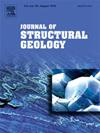3D modeling and visualization of geological structures with python-implemented Bézier curves/surfaces
IF 2.9
2区 地球科学
Q2 GEOSCIENCES, MULTIDISCIPLINARY
引用次数: 0
Abstract
Interactive 3D HTML models and visualizations of geological structures derived from classic surface geological information have been developed, for the first time, in a Python environment, using the key case of the tectonic Mula sheets in the Betic Cordillera (southern Spain). These models were performed through several steps: a geological 2D sketch map, creating equispaced geological cross-sections, 3D topography, a complete 3D model, and detailed 3D block diagrams. The result of the extrapolation of the equispaced geological cross-sections and their integration with the geological map into a 3D geological model shows the thrust-faulted and contractionally folded structure of the entire area, which affects the Cretaceous to Lower Miocene succession. The faults (strike-slip and normal) present in the tectonic thrust sheets are also represented. Three detailed 3D HTML blocks of illustrative regions within the modeled area were also created. For the 3D modeling, Bézier curves/surfaces as well as linear interpolation were used, as geological (stratigraphic and tectonic) contacts and surfaces between different stratigraphic units can be expressed geometrically with these tools. Compared to commercial alternatives, our software offers three key advantages: free user-friendly solutions, browser-compatible 3D models, and open-source software. The 3D visualization of stratigraphic-structural architecture enables predictive interpretations with applications in environmental and economic geology (e.g., groundwater, geotechnical studies, mining research, etc.). Moreover, 3D visualization and modeling provide valuable insights into geological phenomena, benefiting both the scientific community and society at large. Furthermore, advances in interactive 3D visualization bridge the gap between cutting-edge geological research and public understanding, enhancing social awareness.
三维建模和可视化的地质结构与python实现的bsamzier曲线/表面
基于经典地表地质信息的交互式3D HTML模型和地质构造可视化首次在Python环境中开发出来,以西班牙南部Betic Cordillera的Mula构造片为关键案例。这些模型是通过几个步骤完成的:一个地质2D草图,创建等距地质截面,3D地形,一个完整的3D模型,以及详细的3D方框图。对等步地质剖面进行外推,并将其与地质图整合成三维地质模型,显示了整个地区的逆冲断裂和收缩褶皱构造,影响了白垩纪至下中新世的演替。构造逆冲片上的断层(走滑断层和正断层)也有代表性。在建模区域内,还创建了三个详细的3D HTML块,用于说明区域。在三维建模中,由于不同地层单元之间的地质(地层和构造)接触和表面可以用这些工具进行几何表示,因此使用了bsamzier曲线/曲面和线性插值。与商业替代品相比,我们的软件提供了三个关键优势:免费的用户友好解决方案,浏览器兼容的3D模型和开源软件。地层构造的三维可视化使环境和经济地质学(如地下水、岩土工程研究、采矿研究等)的预测解释成为可能。此外,三维可视化和建模为地质现象提供了有价值的见解,有利于科学界和整个社会。此外,交互式三维可视化技术的进步弥合了前沿地质研究与公众理解之间的差距,增强了社会意识。
本文章由计算机程序翻译,如有差异,请以英文原文为准。
求助全文
约1分钟内获得全文
求助全文
来源期刊

Journal of Structural Geology
地学-地球科学综合
CiteScore
6.00
自引率
19.40%
发文量
192
审稿时长
15.7 weeks
期刊介绍:
The Journal of Structural Geology publishes process-oriented investigations about structural geology using appropriate combinations of analog and digital field data, seismic reflection data, satellite-derived data, geometric analysis, kinematic analysis, laboratory experiments, computer visualizations, and analogue or numerical modelling on all scales. Contributions are encouraged to draw perspectives from rheology, rock mechanics, geophysics,metamorphism, sedimentology, petroleum geology, economic geology, geodynamics, planetary geology, tectonics and neotectonics to provide a more powerful understanding of deformation processes and systems. Given the visual nature of the discipline, supplementary materials that portray the data and analysis in 3-D or quasi 3-D manners, including the use of videos, and/or graphical abstracts can significantly strengthen the impact of contributions.
 求助内容:
求助内容: 应助结果提醒方式:
应助结果提醒方式:


